new posts in all blogs
Viewing: Blog Posts Tagged with: josh pincus, Most Recent at Top [Help]
Results 1 - 25 of 193
How to use this Page
You are viewing the most recent posts tagged with the words: josh pincus in the JacketFlap blog reader. What is a tag? Think of a tag as a keyword or category label. Tags can both help you find posts on JacketFlap.com as well as provide an easy way for you to "remember" and classify posts for later recall. Try adding a tag yourself by clicking "Add a tag" below a post's header. Scroll down through the list of Recent Posts in the left column and click on a post title that sounds interesting. You can view all posts from a specific blog by clicking the Blog name in the right column, or you can click a 'More Posts from this Blog' link in any individual post.
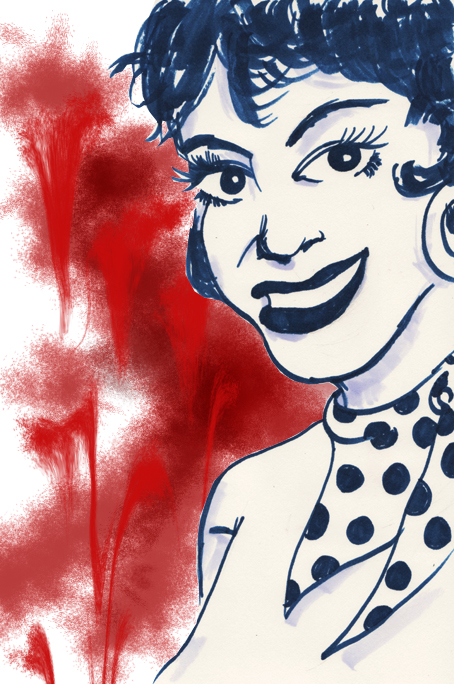
Born Harriet Shapiro on July 9, 1927 in Boston, Susan Cabot grew up shuffled between 8 foster homes. She developed an interest in acting and singing – performing evenings at Manhattan’s Village Barn. A film career seemed destined when the nightclub singer appeared in the 1947 film
Kiss of Death with Colleen Gray and Victor Mature. After the film she remained in New York for a bit and did some television work. She expanded her acting work into television and was seen by a Hollywood talent scout who took her to Hollywood to work for Columbia Pictures. This brief period was not successful, and she moved to Universal Studios where she was signed to an exclusive contract. After a series of roles which Cabot played mainly in "B" western films, she grew frustrated and asked to be released from her contract. Cabot moved back to New York and in 1957 she made a decision that would insure her screen immortality. She signed an exclusive contract with producer
Roger Corman. First up she was the villainous Enger in
The Viking Women and The Sea Serpent. The same year she starred in
Carnival Rock and
Sorority Girl –both costarring
Dick Miller. She followed that with
Machine Gun Kelly in 1958, co-starring a young
Charles Bronson. However, Susan Cabot’s most famous role was also her final film. In 1960, she played cosmetics company president Janice Starlin in
The Wasp Woman. During this time, Cabot had an affair with
King Hussein of Jordan. He eventually dumped her when he discovered she was Jewish.
Cabot gave birth to a son, Timothy in 1963. Timothy suffered from dwarfism. Cabot was almost inseparable from Timothy. She devoted her life to him, insisting he take experimental growth hormones. She began to take her son's hormones, too. The drugs affected their mental stability. Cabot became a recluse. Timothy found solace in weight-lifting equipment.
One night in December 1986, police responded to a call at the Cabot house. When they arrived, Timothy told them that "a tall Latino with curly hair, dressed like a Japanese Ninja warrior", had attacked them both, making off with about $70,000 cash. He told the cops that he fought with the intruder, and was knocked out. According to the autopsy report, Susan Cabot was lying in bed, on her stomach. Her head was covered with a piece of bed linen. They noted blood spatters on the mirrored walls and ceiling and it appeared that she had the linen over her head during the attack. There were no defense wounds.
After becoming suspicious of her son, police questioned him further. Timothy cracked and directed them to the murder weapon. A weight lifting bar, probably from a dumbbell. It was hidden in a box of
Bold 3 laundry detergent, in his hamper.
Timothy received a three-year suspended sentence and was placed on probation.
The Monday Artday challenge this week is "change".

"Even a man who is pure at heart, and says his prayers by night, may become a wolf when the wolfbane blooms and the autumn moon is bright."This quote has been listed in some sources as an authentic Gypsy or Eastern European folk saying. Screenwriter
Curt Siodmak admits that he simply made it up for 1941's
The Wolf Man. However, the rhyme would be recited in every future Universal film appearance of the Wolf Man, and would also be quoted in
Van Helsing (2004).
The challenge at another illustration blog this week is "leap".

faster than a speeding bullet
more powerful than a locomotive
and able to blah blah blah...
The weekly challenge word on another illustration blog is "mechanical".
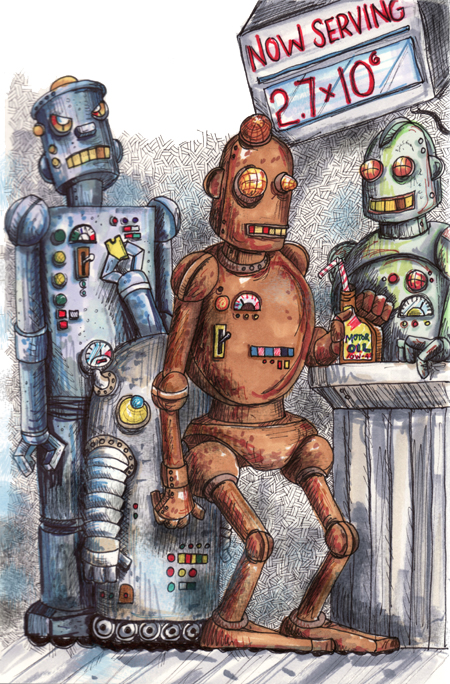
It's always tough finding a spot at the bar at the Piston My Brake Shoes Pub.
The weekly challenge word on
sugarfrostedgoodness.com is
"mechanical".

It's always tough finding a spot at the bar at the Piston My Brake Shoes Pub.
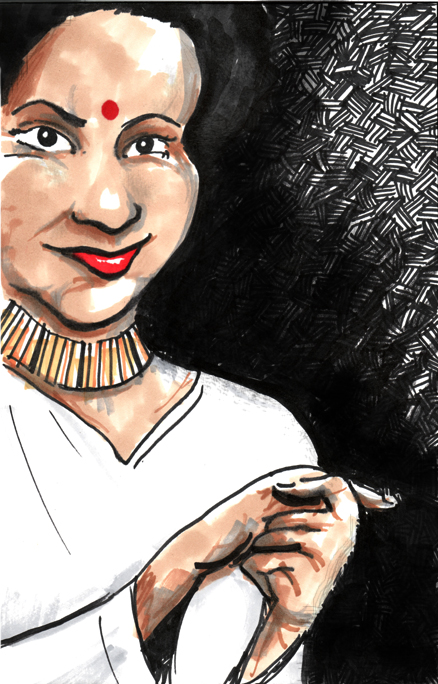
Asha Bhosle is an Indian singer, best known as a Bollywood playback singer. A playback singer is a singer whose singing is prerecorded for use in movies. Playback singers record songs on soundtracks, and actors or actresses lip-sync the songs for cameras.
Her career started in 1943 and has spanned over six decades. She has done playback singing for over 950 Bollywood movies. She is the sister of the equally accomplished Lata Mangeshkar.
Bhosle is considered one of the most versatile South Asian singers — her range of songs includes film music, pop,
ghazals,
bhajans, traditional Indian Classical music, folk songs,
qawwalis,
Rabindra Sangeets and
Nazrul Geetis. She has sung in over 14 languages including Hindi, Urdu, Telugu, Marathi, Bengali, Gujarati, Punjabi, Tamil, English, Russian, Czech, Nepali, Malay and Malayalam.
Asha Bhosle is believed to have sung over 12,000 songs. Though her sister, Lata Mangeshkar was featured in the Guinness Book of World Records during 1974-1991, for having sung the most songs in the world, reputed sources have introduced concerns to its veracity, claiming that the Guinness counts were exaggerated and Bhosle has recorded more songs than Mangeshkar.
CLICK HERE to hear the
Cornershop song that was inspired by Asha Bhosle.
The challenge this week at Monday Artday is "underground".

Vance Palmer was born September 16, 1893. In the early twentieth century, hundreds of boys like Vance worked as "door boys" or "nippers" in coal mines. Door boys were never over fourteen years of age and sometimes as young as ten. The work of the door boy was monotonous. He had to wake early, dress in clothes that were usually dirty with soot, and be in the mine when the first trip of coal cars entered in the morning. He would need to remain in the mine remain until the last car came out at night. The door boys' duty was to open and shut the door as men and coal cars pass through the door, which controls and regulates the ventilation of the mine. That meant sitting alone in a dark mine passage hour after hour, with no human soul near; to see no living creature except the mules as they pass with their loads, or a rat or two seeking to share his meal. It meant standing in water or mud that covers the ankles, chilled to the bone by the cold drafts that rushed in when the trap door was opened for the mules to pass through. It meant working for fourteen hours—waiting—opening and shutting a door—then waiting again. Passing the time by reading was not an option for door boys, as the only light came from their helmet candle. Whittling and whistling were the boy's chief recreations. Door boys would sometimes fall asleep at their post and fail to open their assigned door. In the darkness, a coal car would crash into the closed door, thus slowing down the mining process. And sometimes, a door boy would be killed by a speeding coal car, while attempting to cross the tracks in the darkness.
The door boy's wages would vary from sixty five to seventy five cents a day, and from this he provided his own lamp, cotton and oil or candle.
The challenge this week on another illustration blog is "multiple".

One of the most famous and interesting medical anomalies is the world's only conjoined triplets, Chang and Eng and Archie Bunker. Conjoined twins are a rare phenomenon. It is estimated to occur from 1 in 50,000 births to 1 in 200,000 births. However, there is only one case of conjoined triplets on record.
Chang and Eng were born in May 1811 in the province of Samutsongkram in Siam (now Thailand). Archie, curiously, was born in the Queens borough of New York City in January 1971, nearly 160 years later. Chang and Eng were joined at the sternum by a small piece of cartilage. Their livers were fused but independently complete. Although 19th century medicine did not have the means to do so, modern surgical techniques would have easily allowed them to be separated today. Archie was attached to Eng by a cathode ray tube (CRT).
Chang and Eng and Archie lived productive lives. Chang and Eng, after touring the world with P.T. Barnum, retired and settled in White Plain, North Carolina. Chang and Eng married sisters Adelaide and Sarah Anne Yates. Chang and his wife had ten children; Eng and his wife had twelve. During the American Civil War Chang's son Christopher and Eng's son Stephen both fought for the Confederacy. Many of their descendants still live in the Mount Airy area.
Archie took a different course than his conjoined brothers. He grew up during the depression. He served with the United States Army Air Corp in Foggia, Italy in World War II (The Big One). He married the former Edith Baines and they had one child, Gloria, who much to Archie's chagrin, married a meathead. Unlike his brothers, Archie held many jobs, including Loading Dock Foreman, Janitor, Taxi Driver and finally, Bar Owner.
Eng and Chang died in January 1874, at the age of 63. Chang preceded Eng in death by about two and a half hours. An autopsy indicated that Chang died of a blood clot in the brain; and at the time Eng's demise was attributed, understandably, to shock.
In 1983, Archie didn't die, so much as he was cancelled.
The weekly challenge on another illustration blog is "bad idea".
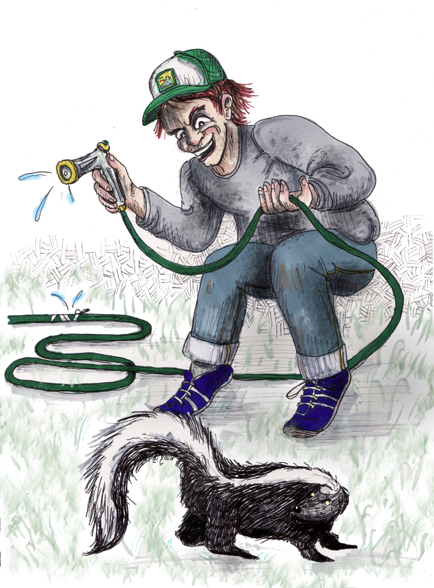
Not a good idea!
The sugarfrostedgoodness.com weekly challenge is "bad idea".

Not a good idea!
The challenge this week on Monday Artday is "getting ready".
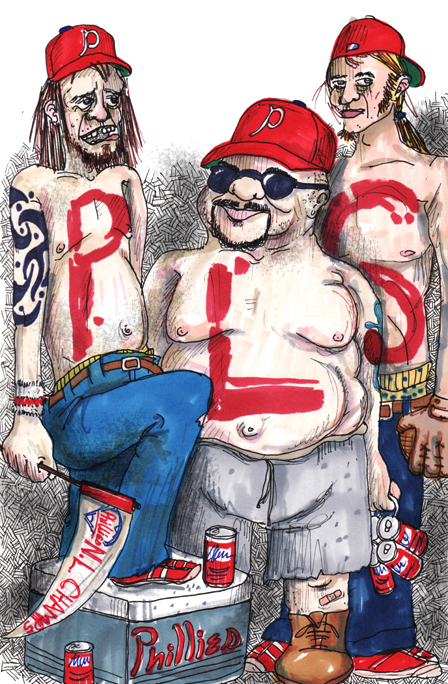
...for Opening Day!
I have mentioned before. I love baseball. I love watching baseball. I love going to baseball games. There are somethings I don't like about baseball (namely
Brett Myers), but overall, I love it.
I have been a Phillies season ticket holder since 1996. That means I suffered through some pretty lousy years. I saw some seasons end with the Phillies
so close to a championship, only to blow it in the final week. Last season, of course, was different. The Phils won the National League East pennant on the last day of the season. I was there. I was there among a deafening crowd. A crowd that screamed for nine straight innings. A crowd made up, mostly, of people who had never been to a baseball game in their lives and were merely jumping on the "post-season bandwagon". Every one of them had loved the Phillies since...well....last week. As it played out, the Phillies post-season lasted three games and the temporary Phillies fans went back to follow the pathetic Philadelphia Eagles or American Idol.
I wouldn't consider myself a "Phillies Fan". It's just that I love baseball and I live in Philadelphia so I have no choice if I want to see a baseball game. Sure, there are several minor leagues in the area. But, if I want to see minor league-caliber baseball, I'll stick with the Phils.
I also worked as a soda vendor at
Veterans Stadium when I was a kid. Veterans Stadium was home to the Phillies for 33 seasons. "The Vet" was, thankfully, imploded in March 2004. In April 2004,
Citizens Bank Park opened. The new home of the Phillies is a beautiful, state-of-the-art facility that rivals many of the great parks in Major League Baseball. I've been to other parks in other cities. Citizens Bank Park is one of the best. Just hurry up and see it before the Phillies fans sh** it up.
The Philadelphia sports fan. An unusual creature, that fan. They are nationally known for their aggressive and angry behavior. Everyone knows, we are
the fans that booed Santa Claus. I've seen a player make a spectacular, multi-run saving catch it the top of an inning and come up to bat in the same inning, pop-up and get chided by the same crowd like he just shot your dog.
And it's
THESE guys.
These guys show up every year. (If not them, then someone like them.) On Opening Day, they love the Phillies. They'll scream, "The Phillies are going ALL THE WAY, BABY! ALL THE WAY TO THE F***IN' WORL' SERIES! DA METS F***IN' SUCK! THE PHILS ARE DA BEST!"
Until the first time Pat Burrell stands at the plate with his bat on his shoulder, thinking about his fifty million dollar contract, while three balls sail through his strike zone.
Then, the screams become, "THEY SUCK! DA PHILLIES SUCK! Hey, where's the beer guy?"
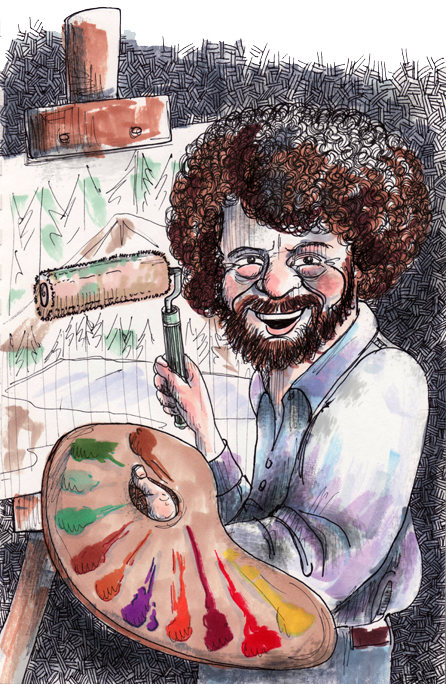
With his calm, patient nature, Bob Ross came to prominence as the creator and host of The Joy of Painting, a long-running instructional program braodcast on public television. The show continues in reruns, even after Ross's death in 1995.
Ross spent twelve years keeping medical records for the U.S. Air Force, which is where he first started painting. After leaving the Air Force, he studied with William Alexander before becoming famous worldwide with his own television program, The Magic of Oil Painting, also a public television staple.
During each half-hour segment of The Joy of Painting, Ross would instruct viewers in the art of oil painting using a quick-study technique that kept colors to a minimum and broke paintings down into simple steps that anyone could follow. Ross acknowledged that the appearances of the landscapes he painted were strongly influenced by his years living in Alaska, where he was stationed for the majority of his Air Force career.
He repeatedly stated on the show his belief that everyone had artistic talent and could become accomplished artists given time, practice, and encouragement, and to this end was often fond of saying, "We don't make mistakes, we just have happy little accidents." When asked about his laid-back approach to painting and eternally calm and contented demeanor, he once commented: "I got a letter from somebody a while back, and they said, 'Bob, everything in your world seems to be happy.' That's for sure. That's why I paint. It's because I can create the kind of world that I want, and I can make this world as happy as I want it. Shoot, if you want bad stuff, watch the news."
Ross utilized the wet-on-wet oil painting technique, in which the painter continues adding paint on top of still wet paint rather than waiting a lengthy amount of time to allow each layer of paint to dry. Combining this method with the use of giant house-painting brushes, large painting knives and fan brushes allowed Ross to paint trees, water, clouds and mountains in a matter of seconds.
In many episodes of The Joy of Painting, Ross noted that one of his favorite parts of painting was cleaning the brush, specifically the act of drying off a brush, which he had dipped in cleaner, by rapping it against the easel frame. He would often smile and even laugh out loud regularly during this practice as he, in his words, "Beat the devil out of it".
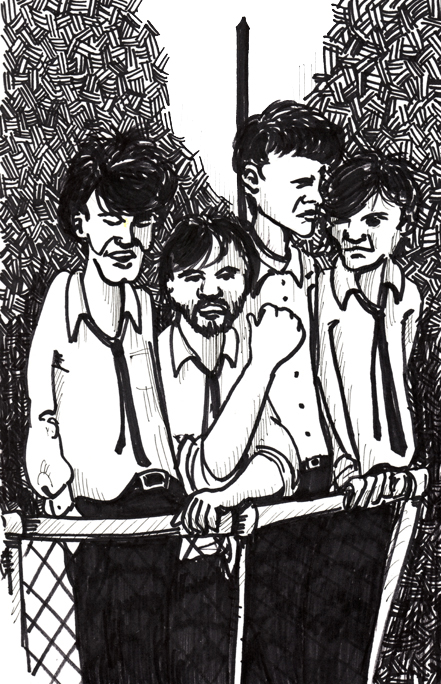
Joy Division were an English rock band formed in 1976 in Greater Manchester. The band consisted of Ian Curtis, Bernard Sumner, Peter Hook and Stephen Morris.
Joy Division rapidly evolved from their initial punk rock influences, developing a sound and style that helped pioneer the post-punk movement of the late 1970s. Joy Division's debut album, Unknown Pleasures, was released in 1979 on independent record label Factory Records, and drew critical acclaim from the British press. Despite the band's rapid success, vocalist Ian Curtis was beset with depression and personal difficulties, including a dissolving marriage and his diagnosis with epilepsy. Curtis found it increasingly difficult to perform at live concerts, and often had seizures during performances.
On the eve of the band's first American tour, Curtis, overwhelmed with depression, committed suicide. Early on the morning of May 18, 1980, Curtis hanged himself in his kitchen. Curtis's wife Deborah, discovered his body when she returned around midday.
Joy Division's posthumously released second album, Closer, and the single "Love Will Tear Us Apart" became the band's highest charting releases. After the death of Curtis, the remaining members reformed as New Order, achieving significant critical and commercial success.
The challenge word on another illustration blog this week is an abstract one. The word is "
theory".

"Anne Elk's Theory on Brontosauruses" is a sketch from an episode of
Monty Python's Flying Circus.
This skit features
Graham Chapman as a television interviewer and
John Cleese in preposterous drag as the palaeontologist, Anne Elk.
The plot of the skit is that the interviewee, Anne Elk, cannot bring herself to describe the actual basis of her supposed new palaeontological theory on brontosauruses. Ms. Elk spends most of the interview clearing her throat and making assertions like "My theory, which belongs to me, is mine."
In the end, Miss Elk's theory on brontosauruses is revealed as "All brontosauruses are thin at one end, much thicker in the middle and then thin again at the far end." Her true concern is that she receive full credit for devising this new theory stating, "That is the theory that I have and which is mine and what it is, too." The interviewer, is disbelief, answers, "Well, Anne, this theory of yours seems to have hit the nail right on the head." To which Anne adds, " ... and it's mine."
The skit coined the concept of "Elk Theories" to describe scientific observations that are not theories but merely minimal accounts.
The challenge word on
sugarfrostedgoodness.com this week is
"joy".
This is the second of two illustrations for the topic.

With his calm, patient nature, Bob Ross came to prominence as the creator and host of
The Joy of Painting, a long-running instructional program braodcast on public television. The show continues in reruns, even after Ross's death in 1995.
Ross spent twelve years keeping medical records for the U.S. Air Force, which is where he first started painting. After leaving the Air Force, he studied with William Alexander before becoming famous worldwide with
his own television program,
The Magic of Oil Painting, also a public television staple.
During each half-hour segment of
The Joy of Painting, Ross would instruct viewers in the art of oil painting using a quick-study technique that kept colors to a minimum and broke paintings down into simple steps that anyone could follow. Ross acknowledged that the appearances of the landscapes he painted were strongly influenced by his years living in Alaska, where he was stationed for the majority of his Air Force career.
He repeatedly stated on the show his belief that everyone had artistic talent and could become accomplished artists given time, practice, and encouragement, and to this end was often fond of saying, "We don't make mistakes, we just have happy little accidents." When asked about his laid-back approach to painting and eternally calm and contented demeanor, he once commented: "I got a letter from somebody a while back, and they said, 'Bob, everything in your world seems to be happy.' That's for sure. That's why I paint. It's because I can create the kind of world that I want, and I can make this world as happy as I want it. Shoot, if you want bad stuff, watch the news."
Ross utilized the
wet-on-wet oil painting technique, in which the painter continues adding paint on top of still wet paint rather than waiting a lengthy amount of time to allow each layer of paint to dry. Combining this method with the use of giant house-painting brushes, large painting knives and fan brushes allowed Ross to paint trees, water, clouds and mountains in a matter of seconds.
In many episodes of
The Joy of Painting, Ross noted that one of his favorite parts of painting was cleaning the brush, specifically the act of drying off a brush, which he had dipped in cleaner, by rapping it against the easel frame. He would often smile and even laugh out loud regularly during this practice as he, in his words, "Beat the devil out of it".
The challenge word on
sugarfrostedgoodness.com this week is
"joy".
This is the first of two illustrations for the topic.

Joy Division were an English rock band formed in 1976 in Greater Manchester. The band consisted of Ian Curtis, Bernard Sumner, Peter Hook and Stephen Morris.
Joy Division rapidly evolved from their initial punk rock influences, developing a sound and style that helped pioneer the post-punk movement of the late 1970s. Joy Division's debut album,
Unknown Pleasures, was released in 1979 on independent record label Factory Records, and drew critical acclaim from the British press. Despite the band's rapid success, vocalist Ian Curtis was beset with depression and personal difficulties, including a dissolving marriage and his diagnosis with epilepsy. Curtis found it increasingly difficult to perform at live concerts, and often had seizures during performances.
On the eve of the band's first American tour, Curtis, overwhelmed with depression, committed suicide. Early on the morning of May 18, 1980, Curtis hanged himself in his kitchen. Curtis's wife Deborah, discovered his body when she returned around midday.
Joy Division's posthumously released second album,
Closer, and the single
"Love Will Tear Us Apart" became the band's highest charting releases. After the death of Curtis, the remaining members reformed as New Order, achieving significant critical and commercial success.
The
Monday Artday challenge this week is
"favorite book".
I actually id an illustration for my favorite book a while ago. My favorite book is
"The Emperors of Chocolate" by Joel Glenn Brenner.
The illustration I did was for the word "chocolate".
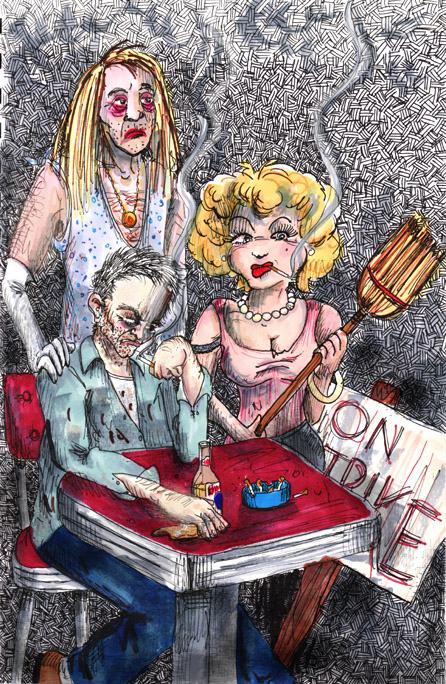
For this challenge, I chose a book that is easily the most affecting and haunting book I ever read.
Last Exit to Brooklyn by Hubert Selby, Jr. was written between 1957 and 1964. It was finally published in 1964. In the Eisenhower era of "
Leave It to Beaver" and "
The Donna Reed Show", this collection of short stories chronicled the lives of the dregs of society. Centered around The Greeks, a scummy dive diner near the Brooklyn Airbase, it brings to life the most disturbing, disgusting characters and their filthy, drug-filled, liquor-filled, perverted sex-filled existence. Written in a "stream-of-consciousness " manner, Selby shows no mercy and no pity for his cast of addicts, spouse-abusers, junkies, pimps, prostitutes, transvestites, pedophiles, alcoholics, kiss-asses and other lowlifes.
My mother talked about this book a lot when I was a teenager. She said it was the most memorable and gut-wrenching book she ever read. She also forbade me to read it. I finally read it twelve years after my mother died.
She was right.
if you read the book, you'll get the joke in my illustration.
This week's challenge is "microscopic".
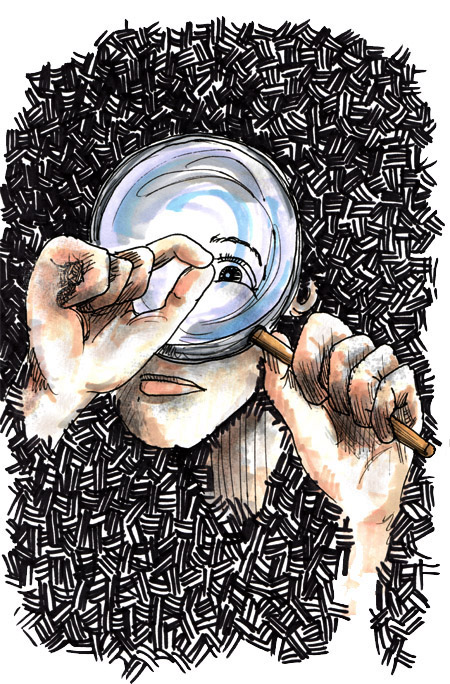
Things don't get much more microscopic than this.
The challenge for this week on another illustration blog is "choose".
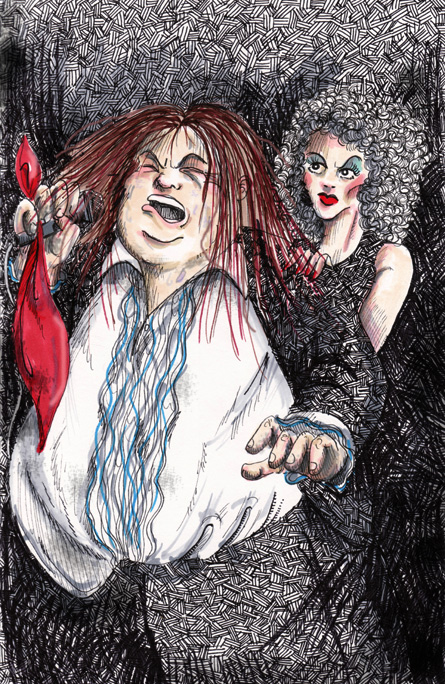
What’s it gonna be boy?
Come on.
I can wait all night
What’s it gonna be boy - yes or no?
What’s it gonna be boy -
yes
or
no?
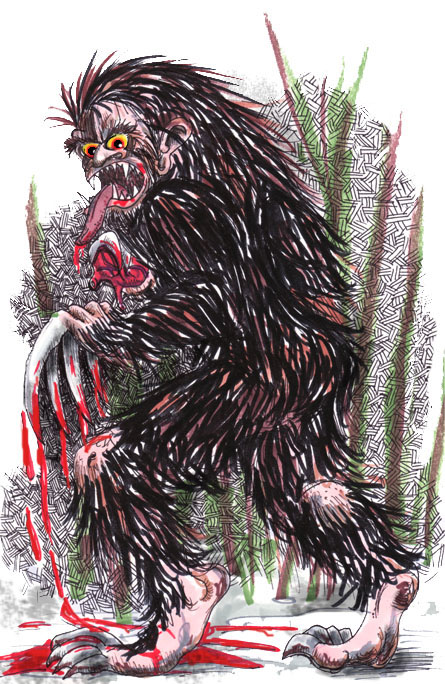
This week's
Monday Artday challenge is an unusual one ― "
half beast".
Somewhere between Bigfoot and werewolves is the legend of the wendigo. The wendigo is a figure appearing in Algonquian Indian mythology. In remote forest areas, sometimes groups of travellers, hunters or campers were cut off from the rest of their party by the bitter snows and ice of the north woods. Conditions became desperate and cannibalism became a necessity in order to survive. The belief was when a human ate human flesh, he would become a wendigo. Among northern Algonquian cultures, cannibalism, even to save one's own life, was viewed as a serious taboo; the proper response to famine was suicide or resignation to death. On one level, the Wendigo myth thus worked as a deterrent and a warning against resorting to cannibalism; those who did would become Wendigo monsters themselves.
Though all of the descriptions of the creature vary slightly, the Wendigo is generally said to have glowing eyes, long yellowed fangs and overly long tongues. Most have a sallow, yellowish skin and are covered with matted hair. They give off a strange and eerie odor of decay and decomposition. They are tall and lanky and are driven by a horrible hunger.
Wendigos were embodiments of gluttony, greed, and excess; never satisfied after killing and consuming one person, they were constantly searching for new victims.
Native Americans actively believed in, and searched for, the Wendigo. One of the most famous Wendigo hunters was a Cree Indian named Jack Fiddler. He claimed to have killed at least 14 of the creatures in his lifetime, although the last murder resulted in his imprisonment at the age of 87. In October 1907, Fiddler and his brother, Joseph, were tried for the murder of a Cree Indian woman. They both pleaded guilty to the crime but defended themselves by stating that the woman had been possessed by the spirit of a Wendigo and was on the verge of transforming into one entirely. According to their defense, she had to be killed before she murdered other members of the tribe. The brothers were to be tired. Just before the trial, Jack escaped and hanged himself. Joseph went to trial and was sentenced to death. No word on his last meal.

The weekly challenge on another illustration blog is "
round".
What happened on the sunny afternoon of November 13, 1982, would change the lives of Ray "Boom Boom" Mancini and Duk Koo Kim and the future of boxing. By the time it was over, Kim lay in a coma from which he would never awaken, dying five days later at the Desert Springs Hospital in Las Vegas.
Ray Mancini inherited his nickname from his father, veteran boxer Lenny "Boom Boom" Mancini. The name perfectly suited the younger Mancini's wild, "whirlwind" fighting style. After a failed attempt against Alexis Arguello, Mancini defeated Arturo Frias and became World Lightweight Champion. Mancini's first defense of his title went easily with a 6th round knockout. But it was his next fight that would change boxing forever.
Duk Koo Kim was brave, but he was wrongly ranked No. 1 by the World Boxing Association. And while his record was 17-1-1, he had but one knockout and had never been tested on a big stage nor faced the kind of force Mancini was at the time. Kim had to labor mightily to get his weight down to the 135-pound limit in the final days leading up to their showdown. Kim made weight, but not without draining himself. Yet round after brutal round, his reaction to being hammered by Mancini was to do what real fighters do. He fought back. He fought back bravely despite obviously hopeless circumstances. He fought back enough that the referee could never justify leaping between them to end Mancini's bombing raids even in the 13th round, when Mancini rocked Kim repeatedly with 40 unanswered shots. It was a fight filled with action, but Mancini had an easy time hitting Kim during the 14 rounds the fight lasted. Kim left the ring on a stretcher. He sustained brain injuries that led to his death five days later. Later, it was reported that taped to the mirror in Kim's dressing room was a note that Kim had written to himself. It read: "Kill or be killed."
Mancini went to the funeral in South Korea and fell into a deep depression afterwards. He said that the hardest moments came when people approached him and asked if he was the boxer who "killed" Duk Koo Kim. Mancini went through a period of reflection, as he blamed himself for Kim's death. Kim's mother committed suicide four months after the fight. The bout's referee, Richard Green, committed suicide in July 1983.
As a result of this bout, the
WBC took steps to shorten its title bouts to a distance of 12 rounds. The
WBA and
WBO followed in 1988 and the
IBF did in 1989. Ray had one final fight in April 1992, against former lightweight champion Greg Haugen. Ray was just a mere shadow of his old self, having only 2 fights in seven years, and the fight was stopped in round seven.
Some years later, singer
Warren Zevon wrote a song called "
Boom Boom Mancini." Among the lyrics are these lines:
When they asked him who was responsible/For the death of Duk Koo Kim
He said, "Someone should have stopped the fight," and told me it was him.
They made hypocrite judgments after the fact/But the name of the game is be hit and hit backIn fact, Mancini had never said the fight should have been stopped, agreeing with most ringside observers that Kim's refusal to retreat made that impossible until he was finally knocked to the floor.
The
sugarfrostedgoodness.com weekly challenge is "
round".

What happened on the sunny afternoon of November 13, 1982, would change the lives of Ray "Boom Boom" Mancini and Duk Koo Kim and the future of boxing. By the time it was over, Kim lay in a coma from which he would never awaken, dying five days later at the Desert Springs Hospital in Las Vegas.
Ray Mancini inherited his nickname from his father, veteran boxer Lenny "Boom Boom" Mancini. The name perfectly suited the younger Mancini's wild, "whirlwind" fighting style. After a failed attempt against Alexis Arguello, Mancini defeated Arturo Frias and became World Lightweight Champion. Mancini's first defense of his title went easily with a 6th round knockout. But it was his next fight that would change boxing forever.
Duk Koo Kim was brave, but he was wrongly ranked No. 1 by the World Boxing Association. And while his record was 17-1-1, he had but one knockout and had never been tested on a big stage nor faced the kind of force Mancini was at the time. Kim had to labor mightily to get his weight down to the 135-pound limit in the final days leading up to their showdown. Kim made weight, but not without draining himself. Yet round after brutal round, his reaction to being hammered by Mancini was to do what real fighters do. He fought back. He fought back bravely despite obviously hopeless circumstances. He fought back enough that the referee could never justify leaping between them to end Mancini's bombing raids even in the 13th round, when Mancini rocked Kim repeatedly with 40 unanswered shots. It was a fight filled with action, but Mancini had an easy time hitting Kim during the 14 rounds the fight lasted. Kim left the ring on a stretcher. He sustained brain injuries that led to his death five days later. Later, it was reported that taped to the mirror in Kim's dressing room was a note that Kim had written to himself. It read: "Kill or be killed."
Mancini went to the funeral in South Korea and fell into a deep depression afterwards. He said that the hardest moments came when people approached him and asked if he was the boxer who "killed" Duk Koo Kim. Mancini went through a period of reflection, as he blamed himself for Kim's death. Kim's mother committed suicide four months after the fight. The bout's referee, Richard Green, committed suicide in July 1983.
As a result of this bout, the
WBC took steps to shorten its title bouts to a distance of 12 rounds. The
WBA and
WBO followed in 1988 and the
IBF did in 1989. Ray had one final fight in April 1992, against former lightweight champion Greg Haugen. Ray was just a mere shadow of his old self, having only 2 fights in seven years, and the fight was stopped in round seven.
Some years later, singer
Warren Zevon wrote a song called "
Boom Boom Mancini." Among the lyrics are these lines:
When they asked him who was responsible/For the death of Duk Koo Kim
He said, "Someone should have stopped the fight," and told me it was him.
They made hypocrite judgments after the fact/But the name of the game is be hit and hit backIn fact, Mancini had never said the fight should have been stopped, agreeing with most ringside observers that Kim's refusal to retreat made that impossible until he was finally knocked to the floor.
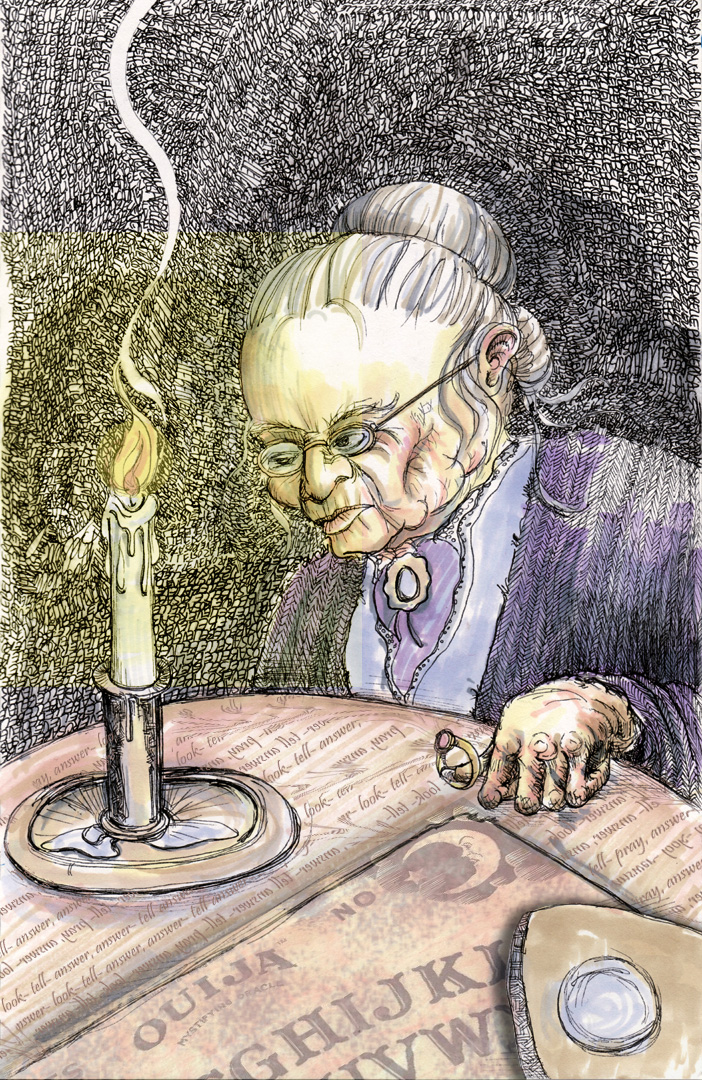
This week's challenge at
Monday Artday is "
hidden message".
Harry Houdini, in addition to being one of the world's greatest magicians, spent a portion of his life exposing fraudulent psychics and bogus clairvoyants. Houdini showed that psychics were using tricks that he, himself, used in his magic act. This practice eventually broke up his friendship with
Sir Arthur Conan Doyle, a great believer in spiritualism.
Prior to his death in 1926, Houdini told his wife Bess (who was also his stage assistant), that if there was a way to send a message from "the other side", he would find that way. The devised a secret message. The message was based on both sentimentality and an old vaudeville mind-reading routine. The message was
"Rosabelle- answer- tell- pray, answer- look- tell- answer, answer- tell". Bess' wedding band bore the inscription "Rosabelle", the name of the song she sang in her act when they first met. The other words correspond to a secret spelling code used to pass information between a magician and his assistant during a "mind-reading" act. Each word or word pair equals a letter. The word "answer" stood for the letter "B", for example. "Answer, answer" stood for the letter "V". Thus, the Houdinis' secret phrase spelled out the word "BELIEVE".
Bess held a yearly seance, on October 31 — the anniversary of her husband's death. In early 1929, a very ill Bess was approached by
Reverend Arthur Ford, a young and eager medium. Within weeks, Ford triumphantly announced that he had successfully delivered the correct message to Houdini's widow. It did not take long for the press to discover that Ford's claim was a hoax; and that Bess had inadvertently revealed the message to several reporters a full year before.
The 1936 séance, atop the Knickerbocker Hotel in Hollywood, was the last one that Bess conducted. Ten years was enough, and she admitted that she had never received the message from Houdini. (Actor William Frawley died in the lobby of the Knickerbocker in 1966. Read all about it
HERE, in a previous post.)
Bess died in 1943 and was not permitted to be buried with her husband at
Machpelah Cemetery because she was a gentile. Bess Houdini is interred at
Gate of Heaven Cemetery in Hawthorne, New York.
(click on the illustration and look for the hidden messages.)
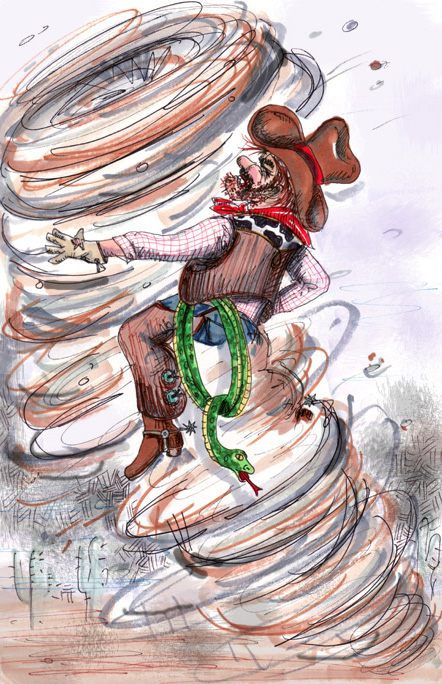
The challenge on another illustration blog this week is "
tales and legends". This is my second entry for this challenge. My first one can be seen
HERE.
The legend of Pecos Bill grew out of the imagination of southwestern range hands who told tall tales to pass the time. The story goes that Pecos Bill, the youngest of eighteen children of a Texas pioneer, was lost in crossing the Pecos River and was brought up by coyotes. He considered himself a coyote until a cowboy convinced him of his true identity, a human being. After returning to civilized territory, Pecos Bill became the cowhand who invented all the tricks of the ranching trade; in various tales he appears as a buffalo hunter, cattleman, railroad contractor, and oilfield worker. His activities include teaching gophers to dig postholes, using a snake as a rope and roping whole herds of cattle at one time. He rode everything in the West, including a mountain lion and a cyclone. He invented the branding iron to stop cattle rustling and the cowboy song to soothe the cattle. On their wedding day, Slue-Foot Sue, Pecos Bill's girl friend, was determined to ride Bill's famous horse, the Widow-Maker, but the animal pitched Sue so high that she almost hit the moon. Her steel-spring bustle continued to bounce her so high that Bill finally shot her to keep her from starving. Pecos Bill's death is a matter of controversy. Some cowboys say that he died from drinking fishhooks with his whiskey and nitroglycerin; others insist that he died laughing at dudes who called themselves cowboys. Whatever the mode of his death, Pecos Bill exists in cowboy folklore as a symbol of the endurance, enterprise and other qualities required of cowboys.
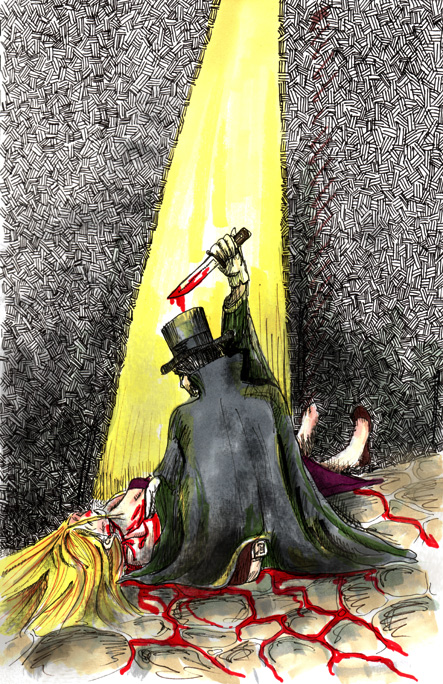
The challenge from another illustration blog this week is "
tales and legends".
Beginning in early 1888, several violent attacks and brutal murders, mainly prostitutes, occurred in rapid succession in and around the Whitechapel area of London. A number of the murders featured extremely gruesome acts, such as mutilation and evisceration. Rumors that the murders were connected intensified in September and October, when a series of extremely disturbing letters were received by various media outlets and Scotland Yard, purporting to take responsibility for some or all of the murders. One letter, received by George Lusk of the Whitechapel Vigilance Committee, included a preserved human kidney.
Files kept by the Metropolitan police show that the investigation begun in 1888 eventually came to include eleven separate murders stretching from April 1888, until February 1891. These became known as "the Whitechapel Murders."
Among the eleven murders actively investigated by the police, five are almost universally agreed upon as having been the work of a single serial killer. These are known collectively as the canonical five victims of Jack the Ripper. These victims were:
Mary Ann Nichols, killed on August 31, 1888. Nichols' body was discovered at about 3:40 in the morning on the ground in front of a gated stable entrance in Buck's Row, a back street in Whitechapel two hundred yards from the London Hospital.
Annie Chapman, killed on September 8, 1888. Chapman's body was discovered about 6:00 in the morning lying on the ground near a doorway in the back yard of 29 Hanbury Street.
Elizabeth Stride, killed on September 30, 1888. Stride's body was discovered close to 1:00 in the morning, lying on the ground in Dutfield's Yard, off Berner Street in Whitechapel.
Catherine Eddowes, killed on September 30, 1888, on the same day as Elizabeth Stride. This circumstance is referred to as the "double event." Her body was found in Mitre Square, in the City of London. Mutilation of Eddowes' body and the abstraction of her left kidney and part of her womb by her murderer bore the signature of a Jack the Ripper killing.
Mary Jane Kelly, killed on November 9, 1888. Kelly's gruesomely mutilated body was discovered shortly after 10:45 a.m. lying on the bed in the single room where she lived at 13 Miller's Court.
By today's crime standards, Jack the Ripper would barely make the headlines, murdering a mere five prostitutes in a huge slum swarming with criminals. Why then, over a hundred years later, are there more books written on the subject of Jack the Ripper than all of the American presidents combined? Why is this symbol of terror as popular a subject today as he was in Victorian London?
Because Jack the Ripper represents the classic whodunit. Not only is the case an enduring unsolved mystery, but the story has a terrifying, almost supernatural quality to it. He comes from out of the fog, kills violently and quickly, and disappears without a trace. Then, for no apparent reason, he satisfies his blood lust with ever-increasing ferocity, culminating in the near destruction of his final victim, and then vanishes from the scene forever. The perfect ingredients for the perennial thriller.
View Next 25 Posts





















WOW! Love your 'Mary Worth' style! Excellent job!
really nice composition, josh!